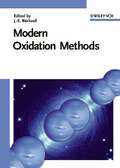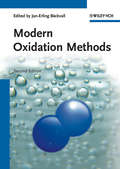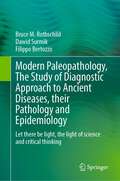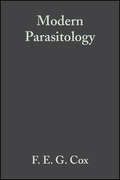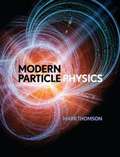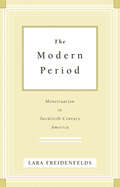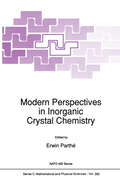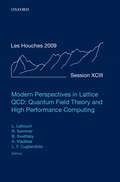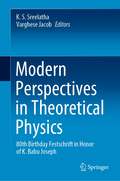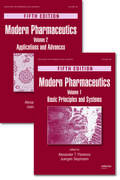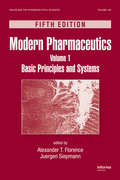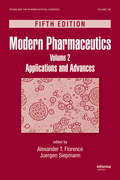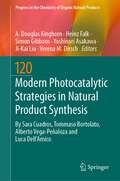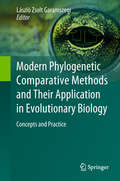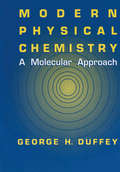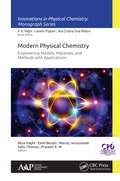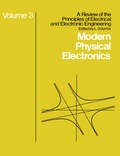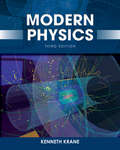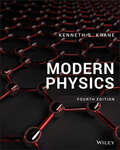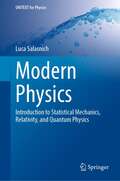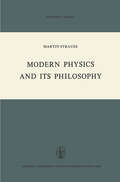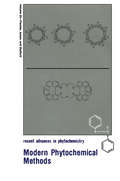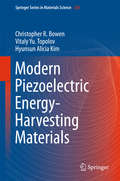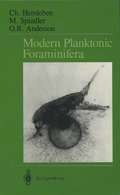- Table View
- List View
Modern Oxidation Methods
by Jan-Erling BäckvallAt the very latest, with the award of the 2001 Nobel Prize for work on asymmetric oxidation, there has been a need for a comprehensive book on such methods. Edited by J.-E. Backvall, one of the world's leaders in the field, this book fills that gap by covering the topic, from classical to green chemistry methods. He has put together a plethora of well-established authors from all over the world who cover every important aspect in high-quality contributions -- whether aerobic oxidation or transition metal-catalyzed epoxidation of alkenes. By providing an overview of this huge topic, this book represents an unparalleled aid for any chemist working in the field. Chapters include: Recent Developments in the Osmium-Catalyzed Dihydroxylation of Olefins Transition Metal-Catalyzed Epoxidation of Alkenes Organocatalytic Oxidation - Ketone-Catalyzed Asymmetric Epoxidation of Olefins Modern Oxidation of Alcohols using environmentally Benign Oxidants Aerobic Oxidations and Related Reactions Catalyzed by N-Hydroxyphthalimide Ruthenium-Catalyzed Oxidation of Alkenes, Alcohols, Amines, Amides, b-Lactams, Phenols, and Hydrocarbons Selective Oxidations of Sulfides and Amines Liquid Phase Oxidation Reactions Catalyzed by Polyoxometalates Oxidation of Carbonyl Compounds Mn-catalysed Oxidation with Hydrogen Peroxide
Modern Oxidation Methods
by Jan-Erling B CkvallWhile rust is an unwanted oxidation reaction, there are also many other useful oxidation reactions that are extremely important and number among the most commonly used reactions in the chemical industry. This completely revised, updated second edition now includes additional sections on industrial oxidation and biochemical oxidation. Edited by one of the world leaders in the field, high-quality contributions cover every important aspect from classical to green chemistry methods: - Recent Developments in Metal-catalyzed Dihydroxylation of Alkenes - Transition Metal-Catalyzed Epoxidation of Alkenes - Organocatalytic Oxidation. Ketone-Catalyzed Asymmetric Epoxidation of Alkenes and Synthetic Applications - Catalytic Oxidations with Hydrogen Peroxide in Fluorinated Alcohol Solvents - Modern Oxidation of Alcohols using Environmentally Benign Oxidants - Aerobic Oxidations and Related Reactions Catalyzed by N-Hydro xyphthalimide - Ruthenium-Catalyzed Oxidation for Organic Synthesis - Selective Oxidation of Amines and Sulfides - Liquid Phase Oxidation Reactions Catalyzed by Polyoxometalates - Oxidation of Carbonyl Compounds - Manganese-Catalyzed Oxidation with Hydrogen Peroxide - Biooxidation with Cytochrome P450 Monooxygenases By providing an overview of this vast topic, the book represents an unparalleled aid for organic, catalytic and biochemists working in the field.
Modern Paleopathology, The Study of Diagnostic Approach to Ancient Diseases, their Pathology and Epidemiology: Let there be light, the light of science and critical thinking
by Bruce M. Rothschild Dawid Surmik Filippo BertozzoThe study of paleopathology has two very different constituencies, the medical scientist and the zoologist/paleontologist/anthropologist. Their investigative procedures and professional jargon are different, sometimes to the point of mutual incomprehensibility. Paleontologists/anthropologists/zoologists have a limited data base for the characterization and interpretation of pathology. This must come from the human and veterinary medical experience.What, beyond intellectual satisfaction, can the health care community expect from this relationship? The past history of the appearance and dispersal of infectious disease and cancer is of considerable theoretical importance and leads to new insights on the nature and transmission of diseases that are otherwise ambiguous. The discovery of rheumatoid arthritis in pre-Columbian North America exemplifies insights gained.The current effort delineates osseous impact of disease (as manifest in clinical populations diagnosed in life), representation in the zoologic, paleontologic and anthropologic record, and assessment techniques that can be confidently applied. The chapters form “columns” that provide the foundation for scientific critical thinking. The actual integration of the information is in its application. Our purpose is to provide a data base and atlas of actually documented skeletal impact of diseases (as population phenomenon), an initial data base of reported skeletal pathology, and a methodology for expanding this to new arenas.The first section of the book examines the scientific basis of paleopathology, its transition from speculation-based musings, resolution of misconceptions and the denouement of paleo-epidemiology. The second section provides holistic analysis of the gamut of pathology/diseases with significant skeletal impact, with a validated archeologic/zoological/paleontological record. The third section provides a glossary to resolve the semantic challenges inherent to interdisciplinary efforts. The fourth section provides an atlas of pathology representation in the fossil record. Ultimately, this book intends to present a scientifically-validated approach to recognition of disease in the archeological, zoological and paleontological record, superseding previous speculation-based offerings.
Modern Parasitology: A Textbook of Parasitology
by F. E. G. CoxThis is a thorough revision and update of the highly successful first edition, which which achieved sales in excess of 4,500. The text serves as a comprehensive introduction to parasitology for both undergraduate and beginning graduate students. In this edition, particular emphasis is placed on parasites of human and veterinary importance. The first three chapters in the text are concerned with how parasites 'work,' their biochemistry, molecular and cell biology and physiology. The remaining chapters cover ecology and epidemiology, immunology and chemotherapy, with the final chapter covering integrated control. This new edition contains new material on cell and molecular biology, vectors and control, which is in contrast to the general biological approach of the first edition. The second edition will succeed the first as the major text on parasitology for students in biology, zoology, microbiology, medicine, veterinary medicine, tropical medicine and public health.
Modern Particle Physics (PDF)
by Mark ThomsonUnique in its coverage of all aspects of modern particle physics, this textbook provides a clear connection between the theory and recent experimental results, including the discovery of the Higgs boson at CERN. It provides a comprehensive and self-contained description of the Standard Model of particle physics suitable for upper-level undergraduate students and graduate students studying experimental particle physics. Physical theory is introduced in a straightforward manner with full mathematical derivations throughout. Fully-worked examples enable students to link the mathematical theory to results from modern particle physics experiments. End-of-chapter exercises, graded by difficulty, provide students with a deeper understanding of the subject. Online resources available at www.cambridge.org/MPP feature password-protected fully-worked solutions to problems for instructors, numerical solutions and hints to the problems for students and PowerPoint slides and JPEGs of figures from the book.
The Modern Period: Menstruation in Twentieth-Century America
by Lara FreidenfeldsThe Modern Period examines how and why Americans adopted radically new methods of managing and thinking about menstruation during the twentieth century. In the early twentieth century women typically used homemade cloth "diapers" to absorb menstrual blood, avoided chills during their periods to protect their health, and counted themselves lucky if they knew something about menstruation before menarche. New expectations at school, at play, and in the workplace, however, made these menstrual traditions problematic, and middle-class women quickly sought new information and products that would make their monthly periods less disruptive to everyday life.Lara Freidenfelds traces this cultural shift, showing how Americans reframed their thinking about menstruation. She explains how women and men collaborated with sex educators, menstrual product manufacturers, advertisers, physical education teachers, and doctors to create a modern understanding of menstruation. Excerpts from seventy-five interviews—accounts by turns funny and moving—help readers to identify with the experiences of the ordinary people who engineered these changes. The Modern Period ties historical changes in menstrual practices to a much broader argument about American popular modernity in the twentieth century. Freidenfelds explores what it meant to be modern and middle class and how those ideals were reflected in the menstrual practices and beliefs of the time. This accessible study sheds new light on the history of popular modernity, the rise of the middle class, and the relationship of these phenomena to how Americans have cared for and managed their bodies.
Modern Perspectives in Inorganic Crystal Chemistry (Nato Science Series C: #382)
by Erwin ParthéThe study of crystal structures has had an ever increasing impact on many fields of science such as physics, chemistry, biology, materials science, medicine, pharmacy, metallurgy, mineralogy and geology. Particularly, with the advent of direct methods of structure determination, the data on crystal structures are accumulating at an unbelievable pace and it becomes more and more difficult to oversee this wealth of data. A crude rationalization of the structures of organic compounds and the atom coordinations can be made with the well-known Kekule model, however, no such generally applicable model exists for the structures of inorganiC and particularly intermetallic compounds. There is a need to rationalize the inorganic crystal structures, to find better ways of describing them, of denoting the geometrical relationships between them, of elucidating the electronic factors and of explaining the bonding between the atoms with the aim of not only having a better understanding of the known structures, but also of predicting structural features of new compounds.
Modern Perspectives in Lattice QCD: Lecture Notes of the Les Houches Summer School: Volume 93, August 2009 (Lecture Notes of the Les Houches Summer School)
The book is based on the lectures delivered at the XCIII Session of the École de Physique des Houches, held in August, 2009. The aim of the event was to familiarize the new generation of PhD students and postdoctoral fellows with the principles and methods of modern lattice field theory, which aims to resolve fundamental, non-perturbative questions about QCD without uncontrolled approximations. The emphasis of the book is on the theoretical developments that have shaped the field in the last two decades and that have turned lattice gauge theory into a robust approach to the determination of low energy hadronic quantities and of fundamental parameters of the Standard Model. By way of introduction, the lectures begin by covering lattice theory basics, lattice renormalization and improvement, and the many faces of chirality. A later course introduces QCD at finite temperature and density. A broad view of lattice computation from the basics to recent developments was offered in a corresponding course. Extrapolations to physical quark masses and a framework for the parameterization of the low-energy physics by means of effective coupling constants is covered in a lecture on chiral perturbation theory. Heavy-quark effective theories, an essential tool for performing the relevant lattice calculations, is covered from its basics to recent advances. A number of shorter courses round out the book and broaden its purview. These included recent applications to the nucleon—nucleon interation and a course on physics beyond the Standard Model.
Modern Perspectives in Theoretical Physics: 80th Birthday Festschrift in Honor of K. Babu Joseph
by K. S. Sreelatha Varghese JacobThis book highlights the review of articles in theoretical physics by the students of Professor K. Babu Joseph, as a Festschrift for his 80th Birthday. This book is divided into four sections based on the contributions of Babu Joseph and his students. The four sections are Cosmology, High Energy Physics, Mathematical Physics and Non-linear Dynamics and its applications.
Modern Pharmaceutics, Two Volume Set
by Alexander T. Florence Juergen SiepmannThis new edition brings you up-to-date on the role of pharmaceutics and its future paradigms in the design of medicines. Contributions from over 30 international thought leaders cover the core disciplines of pharmaceutics and the impact of biotechnology, gene therapy, and cell therapy on current findings. Modern Pharmaceutics helps you stay current
Modern Pharmaceutics Volume 1: Basic Principles and Systems, Fifth Edition
by Alexander T. Florence Juergen SiepmannWith over 100 illustrations, Volume 1 addresses the core disciplines of pharmaceutics (absorption, PK, excipients, tablet dosage forms, and packaging), and explores the challenges and paradigms of pharmaceutics.Key topics in Volume 1 include: principles of drug absorption, chemical kinetics, and drug stability pharmacokinetics the effect of rout
Modern Pharmaceutics, Volume 2: Applications and Advances, Fifth Edition
by Alexander T. Florence Juergen SiepmannVolume 2 addresses the applications and approaches in advanced drug delivery systems, including transdermal, pulmonary, and ocular routes. In addition, this text discusses the impact of the shift to personalized medicines in the fields of pharmaceutical biotechnology, pharmacogenomics, and nanotechnology.Volume 2 investigates: sustained- and contr
Modern Photocatalytic Strategies in Natural Product Synthesis (Progress in the Chemistry of Organic Natural Products #120)
by A. Douglas Kinghorn Heinz Falk Simon Gibbons Yoshinori Asakawa Ji-Kai Liu Verena M. DirschThis book presents recent reports of total syntheses involving a photocatalytic reaction as a key step in the methodology. Modern photocatalysis has proven its generality for the development and functionalization of native functionalities. To date, the field has found broad applications in diverse research areas, including the total synthesis of natural products. Among the selected examples presented in this book, it highlights how the photocatalytic process proceeds in a highly chemo-, regio-, and stereoselective manner, thereby allowing the rapid access to structurally complex architectures under light-driven conditions.
Modern Phylogenetic Comparative Methods and Their Application in Evolutionary Biology: Concepts and Practice
by László Zsolt GaramszegiPhylogenetic comparative approaches are powerful analytical tools for making evolutionary inferences from interspecific data and phylogenies. The phylogenetic toolkit available to evolutionary biologists is currently growing at an incredible speed, but most methodological papers are published in the specialized statistical literature and many are incomprehensible for the user community. This textbook provides an overview of several newly developed phylogenetic comparative methods that allow to investigate a broad array of questions on how phenotypic characters evolve along the branches of phylogeny and how such mechanisms shape complex animal communities and interspecific interactions. The individual chapters were written by the leading experts in the field and using a language that is accessible for practicing evolutionary biologists. The authors carefully explain the philosophy behind different methodologies and provide pointers – mostly using a dynamically developing online interface – on how these methods can be implemented in practice. These “conceptual” and “practical” materials are essential for expanding the qualification of both students and scientists, but also offer a valuable resource for educators. Another value of the book are the accompanying online resources (available at: http://www.mpcm-evolution.com), where the authors post and permanently update practical materials to help embed methods into practice.
Modern Physical Chemistry: A Molecular Approach
by G.H. DuffeyIn this new textbook on physical chemistry, fundamentals are introduced simply yet in more depth than is common. Topics are arranged in a progressive pattern, with simpler theory early and more complicated theory later. General principles are induced from key experimental results. Some mathematical background is supplied where it would be helpful. Each chapter includes worked-out examples and numerous references. Extensive problems, review, and discussion questions are included for each chapter. More detail than is common is devoted to the nature of work and heat and how they differ. Introductory Caratheodory theory and the standard integrating factor for dGrev are carefully developed. The fundamental role played by uncertainty and symmetry in quantum mechanics is emphasized. In chemical kinetics, various methods for determined rate laws are presented. The key mechanisms are detailed. Considerable statistical mechanics and reaction rate theory are then surveyed. Professor Duffey has given us a most readable, easily followed text in physical chemistry.
Modern Physical Chemistry: Engineering Models, Materials, And Methods With Applications (Innovations in Physical Chemistry)
by Reza Haghi Emili Besalú Maciej Jaroszewski Sabu Thomas K. M. PraveenThis volume brings together innovative research, new concepts, and novel developments in the application of new tools for chemical engineers. It presents significant research, reporting on new methodologies and important applications in the field of chemical engineering. Highlighting theoretical foundations, real-world cases, and future directions, this book covers selected topics in a variety of areas, including: chemoinformatics and computational chemistry advanced dielectric materials nanotechniques polymer composites It also presents several advanced case studies. The topics discussed in this volume will be valuable for researchers, practitioners, professionals, and students of chemistry material and chemical engineering.
Modern Physical Chemistry: Engineering Models, Materials, and Methods with Applications (Innovations in Physical Chemistry)
by Reza K. Haghi Emili Besalu Maciej Jaroszewski Sabu Thomas K. M. PraveenThis volume brings together innovative research, new concepts, and novel developments in the application of new tools for chemical engineers. It presents significant research, reporting on new methodologies and important applications in the field of chemical engineering. Highlighting theoretical foundations, real-world cases, and future directions, this book covers selected topics in a variety of areas, including: chemoinformatics and computational chemistry advanced dielectric materials nanotechniques polymer composites It also presents several advanced case studies. The topics discussed in this volume will be valuable for researchers, practitioners, professionals, and students of chemistry material and chemical engineering.
Modern Physical Electronics (A review of the Principles of Electrical & Electronic Engineering #3)
by L. SolymarModern Physics
by Kenneth S. KraneSince its first publication in 1983, Modern Physics has been one of the most widely used texts for the sophomore-level modern physics course for science and engineering students. It covers all the standard topics in the course, including relativity and introductory quantum mechanics, as well as introductions to statistical physics, nuclear physics high energy physics, astrophysics, and cosmology. Modern Physics provides a balanced presentation of both the historical development of all major modern physics concepts and the experimental evidence supporting the theory.
Modern Physics: Introduction to Statistical Mechanics, Relativity, and Quantum Physics (UNITEXT for Physics)
by Luca SalasnichThis book offers an introduction to statistical mechanics, special relativity, and quantum physics. It is based on the lecture notes prepared for the one-semester course of "Quantum Physics" belonging to the Bachelor of Science in Material Sciences at the University of Padova.The first chapter briefly reviews the ideas of classical statistical mechanics introduced by James Clerk Maxwell, Ludwig Boltzmann, Willard Gibbs, and others. The second chapter is devoted to the special relativity of Albert Einstein. In the third chapter, it is historically analyzed the quantization of light due to Max Planck and Albert Einstein, while the fourth chapter discusses the Niels Bohr quantization of the energy levels and the electromagnetic transitions. The fifth chapter investigates the Schrodinger equation, which was obtained by Erwin Schrodinger from the idea of Louis De Broglie to associate to each particle a quantum wavelength. Chapter Six describes the basic axioms of quantum mechanics, which were formulated in the seminal books of Paul Dirac and John von Neumann. In chapter seven, there are several important application of quantum mechanics: the quantum particle in a box, the quantum particle in the harmonic potential, the quantum tunneling, the stationary perturbation theory, and the time-dependent perturbation theory. Chapter Eight is devoted to the study of quantum atomic physics with special emphasis on the spin of the electron, which needs the Dirac equation for a rigorous theoretical justification. In the ninth chapter, it is explained the quantum mechanics of many identical particles at zero temperature, while in Chapter Ten the discussion is extended to many quantum particles at finite temperature by introducing and using the quantum statistical mechanics. The four appendices on Dirac delta function, complex numbers, Fourier transform, and differential equations are a useful mathematical aid for the reader.
Modern Physics and its Philosophy: Selected Papers in the Logic, History and Philosophy of Science (Synthese Library #43)
by M. StraussIn selecting the papers for this volume I have excluded all physics papers proper. I have further omitted all book rev.iews. Instead, I have included two papers not published previously; they are marked by an asterisk (*) in the table of contents. Since many of the papers were occasioned by Symposia or similar gatherings their chronological order is rather accidental. Hence I have tried to group the papers thematically into four parts. Within each part the order of sequence is from the more general to the more special, or from a more popular to a more technical treatment. The same principle has been applied to the sequential order of the parts. The foundational papers on quantum mechanics have been arranged in a somewhat dif ferent manner. Chapters XVI-XIX are concerned with the logic of complementarity while in Chapters XX-XXII a more radical recon ceptualization is carried out. Two of the older papers (Chapters VI and VIII) have been revised to bring them more into line with present terminology. Other papers have been corrected by additions and omissions. Additions are marked by square brackets [ ], while double square brackets [[ II signify omis sions or parts to be omitted. Hence [[A]] [B] means that 'A' should be replaced by 'B'. The heading of one paper (Chapter XX) has been changed to make it more descriptive.
Modern Phytochemical Methods (Recent Advances in Phytochemistry #25)
This volume contains reviews which are based on a symposium, given th at the 30 meeting of The Phytochemical Society of North America, held at Laval University in Quebec City, Canada on August 11-15, 1990. During the past two decades, there have been major new developments in methods which can be applied toward the isolation, separation and structure determination of complex natural products. Therefore, the topic of this symposium, "Modem Phytochemical Methods", is a very timely one. The organizers of the symposium recognized that it would not be possible to cover in detail all new advances in phytochemical methodology. It was therefore decided to emphasize general reviews on recent developments of major separation techniques such as high performance liquid chromatography as well as supercritical fluid chromato graphy. In addition, advances in commonly used structure determination methods, mainly NMR and MS, are reviewed. Other topics include methodo logies of micro-sampling for isolation and analysis of trichome constituents as well as recent breakthroughs on biosynthetic studies of monoterpenes using "enriched" basal cells of trichomes. The volume concludes with a review of quantitative structure-activity relationship (QSAR) studies of biologically active natural products. In Chapter I, K. Hostettmann and his colleagues give a general review of recent developments in the separation of natural products with major emphasis on preparative separations of biologically active plant constituents. The authors present a comparison of droplet countercurrent chromatography (OCCC) with the highly rapid and more versatile centrifugal partition chromatography (CPC).
Modern Piezoelectric Energy-Harvesting Materials (Springer Series in Materials Science #238)
by Christopher R. Bowen Vitaly Yu. Topolov Hyunsun Alicia KimThis book covers the topic of vibration energy harvesting using piezoelectric materials. Piezoelectric materials are analyzed in the context of their electromechanical coupling, heterogeneity, microgeometry and interrelations between electromechanical properties. Piezoelectric ceramics and composites based on ferroelectrics are advanced materials that are suitable for harvesting mechanical energy from vibrations using inertial energy harvesting which relies on the resistance of a mass to acceleration and kinematic energy harvesting which couples the energy harvester to the relative movement of different parts of a source. In addition to piezoelectric materials, research efforts to develop optimization methods for complex piezoelectric energy harvesters are also reviewed. The book is important for specialists in the field of modern advanced materials and will stimulate new effective piezotechnical applications.
Modern Planktonic Foraminifera
by Christoph Hemleben Michael Spindler O. Roger AndersonIn a single volume, the authors bring together a review of current biological understanding of planktonic foraminifera and apply it to developments in sedimentology. With the growing interest in the shells of this class of protozoa as indicators of the history of the earth, revealed through the sedimentary record, a comprehensive analysis of the biology of contemporary foraminifera has become necessary. Main topics covered include Taxonomy, Collecting and Culture Methods, Cellular Ultrastructure, Host and Symbiont Relationships, Trophic Activity and Nutrition, Reproduction, Shell Ontogeny and Architecture, Ecology and Sedimentation and Settlement of Shells.
